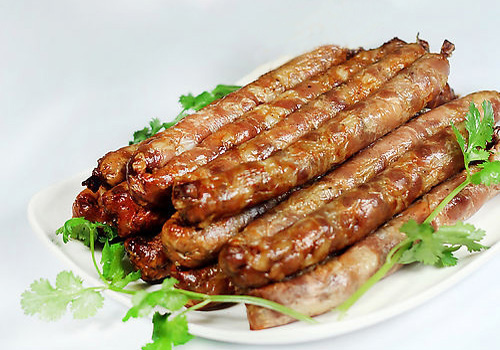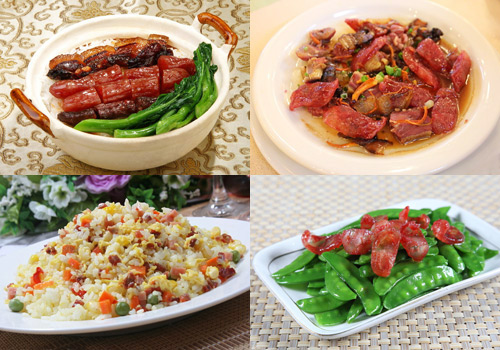A Bite of China- Power of time on sausage
2012-08-09China Food
In terms of preserving food, the intelligent Chinese had already invented various ways in the remote ancient; curing, drying, pickling, smoking, and freezing are the most frequently used, which can not only retain the food but also created some entirely different tastes differing from the fresh. Up to this day, though modern hi-technology has been applied in maintaining the fresh flavor of the food material, the special flavors of Chinese food that recreated by the time by means of traditional ways of food-keeping are still obsessing for people as a indispensable part because they are both the tastes of one’s hometown and some kind of emotions of the traditional Chinese culture.
To enjoy the dainties in severe winter, people prefer to pickle vegetables in North China as fresh greens are not readily available; while in South China the situation is totally different that people like preserved meat better due to the humid climate. In the past, meat have been curried, dried or smoked were only cooked homely, however, these distinctive dishes are also served in the tables today even in superb restaurants.

In the world-famous metropolis of Hong Kong, which is crowned as a Food Paradise assembling a wide range of delicacies from every corner of the world, the indigenous Hong Kongers always have a particular feeling to the traditional aerating dried meat. Preserved duck is a kind of tasty that all the older generation of Hong Kong will covet, which has tender meat and crisp bones serving as the best ingredients for the famed Dried Duck and Li Taro Soup. Yet for all Hong Konger, elders and youngers, the outstanding made Chinese sausage is more popular in a traditional Cured Meat Shop.

To control the quality of sausage, in modern Hong Kong, there are still a few time-honored shops selling the sausages that made completely by hands as the old generations did. The prepared casings for sausage which are made of pork intestines should be stored for one year before filling. The fillings are superior pork, especially those with three portions of fatty meat and seven portions of lean meat. Diced pork, add into flavorings (basically salt, soy, sugar and some rice wine), fully mix them by hand, and then seal up for curing. 24 hours later, when the fillings are ready, it is the time to fill the casings. After filling finished, use rake (with pins) prick the casing to squeeze out redundant air and then use straw rope or hemp rope to bubble the sausage into small sections (usually 15 centimeters for a section). Only a veteran worker can be capable to make the bunchy sausages in orderliness and elegant appearance. In the old days, sausages are natural dried hanging in the sun; while today, because the climate is more humid, sausages are difficult to be dried out utterly that they have to be dried indoors by virtue of soft fire. About one week’s baking, the sausages are done and the alluring fragrant of the meat will spread all over the space.
As a matter of fact, sausages are made in most areas of China, and in countryside, they are smoked to be done in the kitchen. Chinese sausages are usually eaten after steamed, and the typical way is to be steamed in a clay pot with rice; a pot of rice fully soaked with sausage juice is always an exciting food in the severe winter. In addition to this, sausages are also enjoyed after stir-frying with rice, kinds of vegetables or ingredients.

The workers in a sausage factory are quiet busy throughout the year, and will more toilsome in hot summer. Nowadays, young people are unwilling to engage in such a hard work, and this unique flavor completely created by hands with heart may disappear in the future. The old workers regretless tell that in fact, if spend more time to understand this thing you are doing, you can definitely be rewarded with a strong feeling of success.
---By April (VisitOurChina)
Preview:The bamboo trades up and down in Guilin
Next:A Bite of China – the Secret of Black Pottery in the Kitchen




